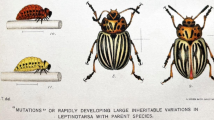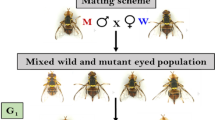Abstract
Stripe (st+) is a dominant trait on chromosome 3R in region 33B on the cytological chromosome map of Anopheles albimanus. It is expressed as a white longitudinal stripe in fourth stage larvae and pupae, and marks a Y-autosome translocation stock T(Y; 3R)3. Pseudolinkage analysis of the available markers to the translocation breakpoint showed complete absence of recombinant progeny between T(Y;3R)3 and st+. The two loci most likely either overlap or are very closely linked. This translocation strain can be genetically sexed by selection of the stripe marker.
Résumé
Stripe (st+) est un caractère dominant localise sur le chromosome 3R de la region 33B de la carte chromosomique de Anopheles albimanus. Ce caractère s’exprime comme une bande blanche longitudinale dans les larves et pupae du/quatrième étage et correspond a une souche T(Y;3R)3 caractérisée par une translocation Y-autosomique. Une analyse pseudoliaison entre les marqueurs disponibles et le point de rupture de la translocation a montre une absence complete de descendance recombinante entre T(Y; 3R)3et st+. Les deux loci sont probablement superposes ou lier très étroitement. Le sexe de la souche transloquée/peut être determine génétiquement par selection du marqueur stripe.
Similar content being viewed by others
References
Asman S. M, McDonald P. T. and Prout T. (1981) Field studies of genetic control systems for mosquitoes. A. Rev. Ent. 26, 289–318.
Ayala F. J., Powell J. R., Tracey M. L., Mourao C. A. and Peres-Salas S. (1972) Enzyme variability in the Drosophila willistoni group. IV. Genetic variation in natural populations of Drosophila willistoni group. Genetics 70, 113–139.
Baker R. H., Sakai R. K. and Saifuddin U. T. (1978) Genetic sexing technique for a mosquito sterile male release. Nature 274, 253–255.
Baker R. H., Sakai R. K. and Raana K. (1981) Genetic sexing for the mosquito sterile male release. J. Hered. 72, 216–218.
Curtis C. F. (1978) Genetic sex separation in Anopheles arabiensis and the production of sterile hybrids. Bull. Wld Hlth Org. 56, 453–54.
Curtis C. F., Akiyama J. and Davidson G. (1976) A genetic sexing system in Anopheles gambiae species A. Mosquito News 36, 493–98.
Foster G. C., Whitten M. J., Prout T. and Gill R. (1972) Chromosome rearrangements for the control of insect pests. Science 176, 875–880.
International Atomic Energy Agency (1983) Report on research coordination meeting on the development of sexing mechanisms in fruit flies through manipulation of radiation-induced lethals and other genetic means, pp. 16–17. Vienna, Austria.
Kaiser P. E., Seawright J. A., Dame D. A. and Joslyn D. J. (1978) Development of a genetic sexing system for Anopheles albimanus U. J. econ. Ent. 71, 766–771.
Kaiser P. E., Seawright J. A. and Joslyn D. J. (1979) Cytology of a genetic sexing system in Anopheles albimanus. Can. J. Genet. Cytol. 21, 201–211.
Keppler W. J. Jr, Kitzmiller J. B. and Rabbani M. G. (1973) The salivary gland chromosomes of Anopheles albimanus. Mosquito News 33, 42–49.
McDonald I. C. (1971) A male-producing strain of the housefly. Science 111, 489.
Narang S. and Seawright J. A. (1983a) Genetic mapping and characterisation of aldehyde oxidase of Anopheles albimanus (Diptera: Culicidae). Biochem. Genet. 21, 653–660.
Narang S. and Seawright J. A. (1983b) Genetic and physiochemical studies on β-hydroxy acid dehydrogenase in Anopheles albimanus. Biochem. Genet. 21, 885–893.
Narang S., Seawright J. A. and Joslyn D. J. (1981) Inheritance and mapping of hexokinase-1 and phosphoglucomutase in Anopheles albimanus. Mosquito News 41, 99–106.
Narang S., Seawright J. A. and Willis N. L. (1984) Assignment of glutamate oxaloacetate transaminase to chromosome 2 and alcohol dehydrogenase to chromosome 3 of Anopheles albimanus. Can. J. Genet. Cytol. 26, 590–594.
Rabbani M. G. and Kitzmiller J. B. (1972) Chromosomal translocations in Anopheles albimanus Wiedemann. Mosquito News 32, 421–432.
Rabbani M. G. and Seawright J. A. (1976) Use of Yautosome translocations in assigning the stripe locus to chromosome 3 in the mosquito Anopheles albimanus. Ann. ent. Soc. Am. 69, 266–268.
Robinson A. S. and Heemert C. van (1981) Genetic sexing in Drosophila melanogaster using the alcohol dehydrogenase locus and a Y-linked translocation. Theoret. appl. Genet. 59, 23–24.
Robinson A. S. and Heemert C. van (1982) Ceratitis capitata, a suitable case for genetic sexing. Genetica 58, 229–237.
Rossler Y. (1979) Automated sexing of Ceratitis capitata (Diptera: Tephritidae): the development of strains with inherited, sex-limited pupal color dimorphism. Entomophaga 24, 411–416.
Seawright J. A., Haile D. G., Rabbani M. G. and Weidhaas D. E. (1979) Computer simulation of the effectiveness of male-linked translocations for the control of Anopheles albimanus Wiedemann. Am. J. trap. Med. Hyg. 28, 155–160.
Seawright J. A., Kaiser P. E. and Narang S. (1981a) Chromosome manipulation studies of Anopheles albimanus for genetic control. In Cytogenetics and Genetics of Vectors (Edited by Pal R., Kitzmiller J. B. and Kanda T.), pp. 249–261. Elsevier Biomedical, New York.
Seawright J. A., Kaiser P. E., Suguna S. G. and Focks D. A. (1981b) Genetic sexing strains of Anopheles albimanus Wiedemann. Mosquito News 41, 107–114.
Seawright J. A., Benedict M. Q., Suguna S. G. and Narang S. (1982) Redeye and vermillion eye, recessive mutants on the right arm of chromosome 2 in Anopheles albimanus. Mosquito News 42, 590–593.
Steiner W. W. M. and Joslyn D. J. (1979) Electrophoretic techniques for the genetic study of mosquitoes. Mosquito News 39, 35–54.
Whitten M. J. (1969) Automated sexing of pupae and its usefulness in control by sterile insects. J. econ. Em. 62, 272–273.
Whitten M. J., Foster G. C., Arnold J. T. and Konowalow C. (1975) The Australian sheep blowfly, Lucila cuprina. In Handbook of Genetics, Vol. 3, Invertebrates of Genetic Interest (Edited by King R. C), pp. 401–418.
Willis N. L., Smittle B. J. and Seawright J. A. (1980) A genetic sexing system for Stomoxys calcitrans. Proceedings of the Florida Anti-Mosquito Association, 51st Meeting Vol. 51, pp. 52–54.
Author information
Authors and Affiliations
Rights and permissions
About this article
Cite this article
Mukiama, T.K. Y-Autosome Genetic Sexing Strain of Anopheles albimanus (Diptera: Culicidae). Int J Trop Insect Sci 6, 649–652 (1985). https://doi.org/10.1017/S1742758400002836
Received:
Revised:
Published:
Issue Date:
DOI: https://doi.org/10.1017/S1742758400002836




